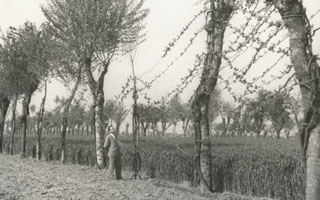Rows of trees and grapevines

A particular system of planting trees and grapevines “a piantata” was used on the farms of the Bolognese plains until the mid-1900s. Trees and vines were positioned and linked in long rows running north-south along the sides of the fields to minimize the shading of the crops. Rows could be planted either “a rivale” or “a cavalletto”. In the former, a single ditch was dug on the west side of the row. In the latter, two ditches were formed, one on the east and one on the west, leaving a strip about 6 meters wide in the center for the trees and vines. Documentation on the cavalletto method, used on land with poor drainage, dates back to the 19th century.
The piantata system allowed for the timely drainage of rainwater. In addition, the high yield of grapes and wines produced by this method contributed not only to the tenant farmer family’s subsistence, but also to the provisioning of urban centers. Regular pruning and planting of the piantata assured a supply of timber for firewood and other uses for the family, for sale at market and as fodder for the animals.
The piantata was therefore perfectly inserted into the sharecropping operation, guaranteeing a certain degree of self-sufficiency for the tenant farmer. Positioned on the edges of the fields, it also protected the crops from strong winds and, during the hot summer, provided workers with a respite from the heat during their brief breaks.